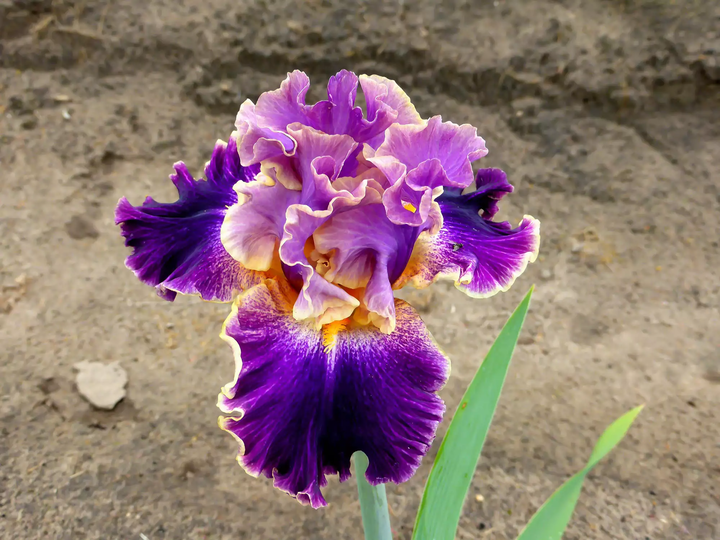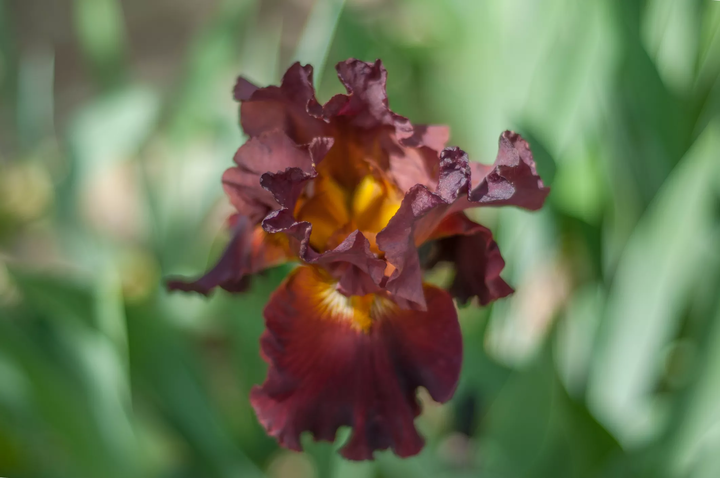Few flowers can boast the diversity and distribution of the Iris genus, which includes several distinct groups, each with unique cultural needs. Although all irises share sword-like leaves and flowers with six spreading or drooping lobes, there are groups that grow from creeping rhizomes while others grow from bulb structures; some iris groups are categorized as "bearded," others as "beardless," and still others as "crested." Japanese, Dutch, and Siberian iris are among those that fall into the beardless category. The bearded iris (Iris germanica) is arguably the most popular of the types, and among the easiest to grow.
A Very Old Genus of Plants
The great diversity of subtypes within the Iris genus owes to the fact that this plant evolved about 82 million years ago, which has given it time to diversify and adapt to different conditions. For this reason, there are irises that thrive in moist, boggy conditions, others that enjoy bone-dry alpine soil; irises that love full intense sun, and others that do well in shade. The diversity only increased under the influence of horticulturalists in the last 200 years, who have bred irises of every color imaginable.
Categories of Bearded Iris
Within the broad category of the popular bearded iris group, there are also subcategories: tall bearded, intermediate bearded, short bearded, miniature bearded, and border bearded. The main distinguishing feature of these subcategories is their stature, although they also vary somewhat in bloom time.
The iris genus derives its name from the Greek goddess of the rainbow, for irises come in every color of the rainbow and then some, offering quirky black and brown hues for those who long for something different in their garden designs. The bearded iris group is among the most diverse—a fact that owes to the long history of this plant.
Botanical Name:
Iris germanica
Common Name:
Bearded iris
Plant Type:
Hardy rhizomatous perennial
Mature Size:
12 to 40 inches tall, with a spread of 1 to 2 feet
Sun Exposure:
Full sun
Soil Type:
Average with good drainage
Bloom Time:
Spring
Flower Color:
Red, orange, yellow, blue, purple, brown, white, black, pink
Hardiness Zones:
3 to 9, USDA
Native Area:
Southern Europe and the Mediterranean

How to Grow Iris
The most popular of the irises, bearded irises are easy to grow provided that you plant them in a sunny site with well-drained soil. Plant irises in late summer, when they are finished actively growing. One major departure of growing irises compared to other perennials: They do not like mulch. Mulches (as well as deep planting) encourage the rhizomes to develop rot, so let your soil remain bare. Space plants at least 12 inches apart to prevent the need for frequent dividing.
Light
Irises need full sun to thrive. Irises in full shade produce fewer blooms and may suffer from an increase in diseases.
Soil
Heavy clay soils do not work well for growing iris, but sandy or gravelly soils are excellent. If your native soil is heavy, you can plant irises in raised beds to help drainage. You may also amend your soil with gypsum or organic matter like compost to lighten the soil.
Water
Although irises like moisture, they also need good drainage to prevent rot problems. Water them when the top 2 inches of the soil feels dry. These plants have a good tolerance for drought.
Temperature and Humidity
Irises are notorious for their hardy disposition. They don't mind temperature extremes, as long as the soil allows excess rain or snowmelt to drain away. Irises that are damaged by heavy winds or hail can be susceptible to iris borer larvae entering the plants.
Fertilizer
In the spring, apply a low-nitrogen 6-10-10 fertilizer around your irises. Too much nitrogen will encourage foliage at the expense of blooms. Bone meal is also a good fertilizer.
Propagating
Dividing irises will not only yield more plants for your garden, but it will also keep your existing irises healthy and vigorous. Dig up the rhizomes in August, and cut them apart, making sure each rhizome has one foliage fan. Divide irises every three to five years, or more often if iris borers have infiltrated the plants.
Varieties of Iris
New named varieties of bearded iris are developed for commercial sale every year, and the ranking of the most popular irises, conducted annually by the American Iris Society, changes frequently. When looking for irises to plant, it's a good idea to look for those that have won well-known awards, such as the Dykes medal.
The five most popular tall bearded irises in 2018 were:
Dusky Challenger: a very dark purple iris, growing to 39 inches tall and blooming in late mid-season
Thornbird: a beautiful yellow iris that grows to 37 inches and blooms in late mid-season
Queen's Circle: white with blue-lavender fringes, this iris grows to 32 inches and blooms in late mid-season
That's All Folks: a towering 40-inch yellow-gold iris that blooms in mid-season
Jesse's Song: a 35-inch tall violet and white iris that blooms in early mid-season

Toxicity of Iris
Irises are toxic to cats and dogs, especially the rhizomes. The plants contain resinous purgative irisin and cytotoxic terpenoids that can cause severe vomiting, drooling, and diarrhea, and sometimes leads to death. Seek medical assistance if a pet has ingested iris; treatment may include induced vomiting or giving the animal activated charcoal.
Pruning
Trimming back foliage fans to about 6 inches in the fall makes the garden look tidy, reduces leaf surface area that might host fungal disease, and removes caterpillar eggs. Destroy all foliage that you remove, and do not add it to the compost bin.
Growing in Containers
Although it's not a common method, you can grow irises in pots that are at least 12 inches wide. Use a loose, soil-free potting mix, and leave the tops of the rhizomes exposed. Make sure not to overwater the plants. In colder climates, you may need to move the containers to sheltered locations for the winter to ensure the plants' survival. Irises in containers may need dividing and transplanting more frequently than those growing in the ground—about every other year or so.
Common Pests and Diseases
The iris borer is the most serious insect pest of irises. In the spring, caterpillars hatch and tunnel through leaves, reaching the rhizome by summer. Feeding tunnels allow the rhizome to become infected with bacterial rot, compounding the damage. Remove all iris leaves after frost to remove caterpillar eggs, as well. Where rhizomes are penetrated by worms, dig them up, cut away soft, infested portions, and replant the pieces. This is a good time to propagate your irises by division.
Major disease problems include bacterial soft rot, crown rot fungus, and fungal leaf spot. Mottling of leaves and flowers suggests the presence of mosaic virus. Affected plant material should be removed and destroyed (not placed in compost).
Iris Compared to Gladiolus
As members of the Iridaceae family, both irises and gladiolus flowers have strap-like foliage and large showy blooms in a wide range of colors. However, the gladiolus is a tender perennial that grows from a corm, and it will not return in zones colder than 7. Gladiolus flowers grow in groups staggered along a single stalk, making them valuable cut flowers.